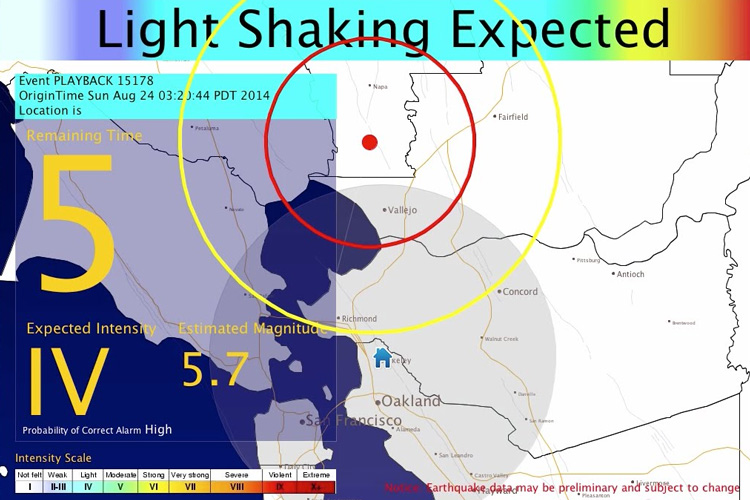BART tests earthquake early warning system as ShakeAlert becomes available to all Bay Area organizations

October 5, 2018
ATTENTION: Reporters covering transportation, emergency preparedness
WHAT: A systemwide demonstration of BART’s response to an earthquake early-warning alert from the ShakeAlert system, which is now being offered to all Bay Area businesses, utilities and app developers.
Following the test, federal and state legislators, BART officials and UC Berkeley seismologists will hold a press conference to announce the newest version of ShakeAlert, emphasize its key role in protecting public safety and infrastructure and make a case for continued federal and state funding to expand the system throughout the earthquake-prone West Coast.
WHEN: Between 11 and 11:15 a.m. Monday, Oct. 8, trains will slow to 27 miles per hour and stations and trains will broadcast an alert to passengers in a test of BART’s response to a real ShakeAlert warning.
Reporters are invited to ride along with VIPs in a special “Fleet of the Future” car that will depart the MacArthur BART Station in Oakland at around 11 a.m. bound for Richmond. Everyone will disembark at the Downtown Berkeley station in time for the 11:20 a.m. press conference about the ShakeAlert system.
WHERE: MacArthur BART Station, 555 40th St., Oakland, and Downtown Berkeley BART station at Shattuck Avenue and Center Street.
WHO:
- Congressman Adam Schiff (D-Burbank)
- State Senator Jerry Hill (D-San Mateo)
- State Senator Bob Wieckowski (D-Fremont)
- Oakland Mayor Libby Schaaf
- John McPartland, BART board member
- Richard Allen, director of the UC Berkeley Seismological Laboratory and one of the originators of the ShakeAlert system
DETAILS: BART was one of the first organizations to test ShakeAlert 1.0, and has been slowing or stopping trains in advance of expected shaking for a couple of years. Monday’s demonstration and press conference mark the formal rollout of a revised version – ShakeAlert 2.0 – which was developed by the U.S. Geological Survey, UC Berkeley, California Institute of Technology, University of Washington and University of Oregon in partnership with the California Governor’s Office of Emergency Services to provide up to tens of seconds of advance warning that the ground will begin shaking: enough time for people to drop, cover and hold on, or take other protective action.
Earthquake alerts also allow manufacturers, utilities and other organizations to establish automatic systems that will initiate actions to protect employees, equipment and delicate operations from injury or damage during shaking. This includes not only stopping trains, but opening firehouse doors so that engines don’t become trapped, shutting off valves to conserve water for firefighting and shutting down gas or chemical lines at industrial sites to prevent fires or leakage.
The USGS is inviting software developers and other partners to create pilot projects that demonstrate the use of ShakeAlert notifications. Some projects, for example, may alert individuals via cellphone, bringing real-time earthquake warnings to the general public. Such public apps are widely used in Japan and Mexico, tied to those countries’ early warning systems.
Legislators in Washington, D.C., and Sacramento have been very supportive of ShakeAlert: the state has provided $25 million over the past two years and the federal government to date has provided $46.3 million to implement it. But continued funding is needed to allow the partners to build out their earthquake-monitoring networks to cover the entire state, as well as Washington and Oregon, and to keep ShakeAlert operating effectively.